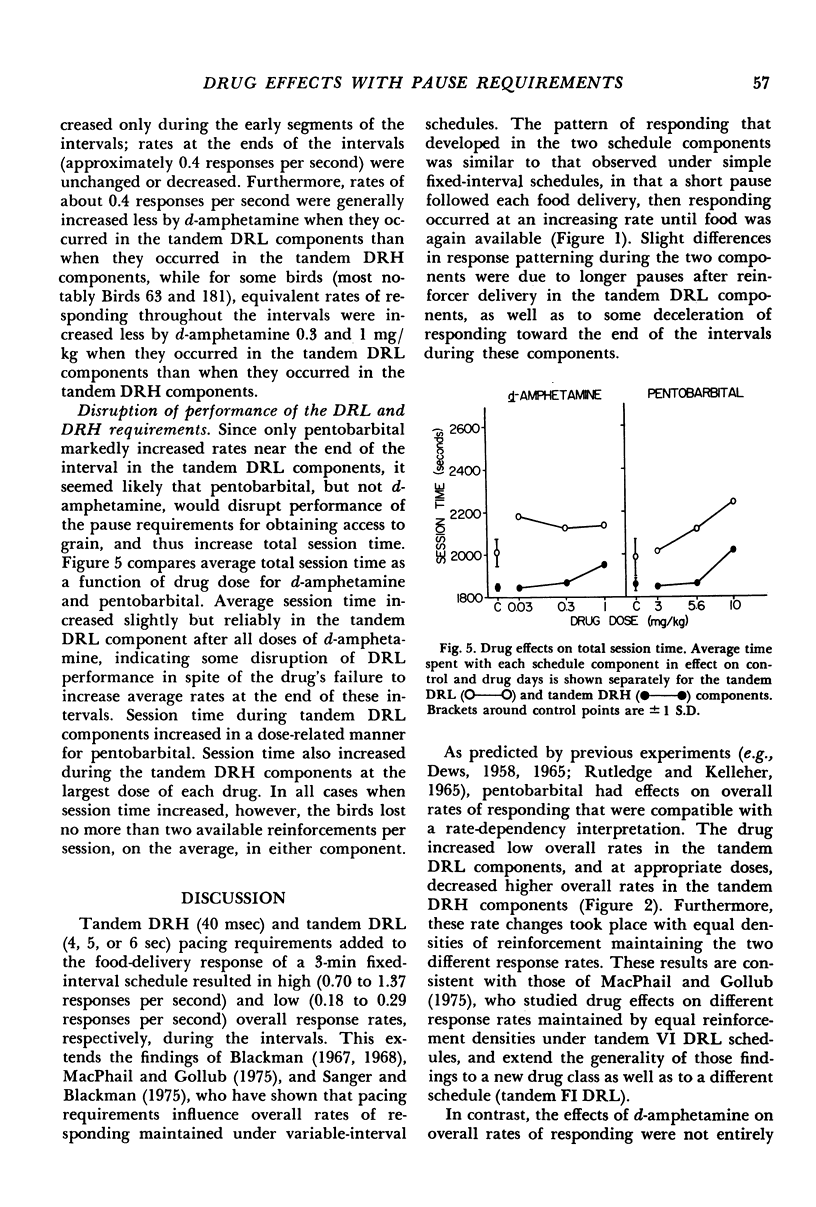Abstract
In pigeons performing under a multiple schedule of food presentation, low key-pecking rates (0.18 to 0.29 responses per second) were maintained during 3-min fixed-interval components by requiring a 4-, 5-, or 6-sec pause preceding the food-delivery response (tandem DRL), while higher rates (0.70 to 1.37 responses per second) were maintained in alternative fixed-interval components by requiring a pause of no more than 40 msec preceding the food-delivery response (tandem DRH). Thus, reinforcement density was equal but overall response rates markedly different in the two schedule components. Pentobarbital (3, 10 mg/kg) had effects on overall rates of responding consistent with a rate-dependency interpretation (low rates were increased while higher rates were decreased), but d-amphetamine (0.03 to 3 mg/kg) either failed to increase low overall rates in the tandem DRL components or increased them only slightly. Effects of both drugs on local responding within the fixed-intervals were always related in an orderly way to control response rate, but the extent of rate increases produced by d-amphetamine was modifed in some birds by pause requirements such that the drug increased comparable rates less when these occurred in the tandem DRL component than when they occurred in the tandem DRH components. Control rate is an important determinant of drug effects, independent DRH components. Control rate is an important determinant of drug effects, independent of reinforcement density maintaining rates, and independent of environmental influences, such as response-spacing requirements for food presentation, that can modify the extent of some drug-produced rate changes.
Full text
PDF








Selected References
These references are in PubMed. This may not be the complete list of references from this article.
- Blackman D. Effects of response pacing on conditioned suppression. Q J Exp Psychol. 1967 May;19(2):170–174. doi: 10.1080/14640746708400088. [DOI] [PubMed] [Google Scholar]
- Blackman D. Response rate, reinforcement frequency, and conditioned suppression. J Exp Anal Behav. 1968 Sep;11(5):503–516. doi: 10.1901/jeab.1968.11-503. [DOI] [PMC free article] [PubMed] [Google Scholar]
- DEWS P. B. Studies on behavior. IV. Stimulant actions of methamphetamine. J Pharmacol Exp Ther. 1958 Jan;122(1):137–147. [PubMed] [Google Scholar]
- GOLLUB L. R. THE RELATIONS AMONG MEASURES OF PERFORMANCE ON FIXED-INTERVAL SCHEDULES. J Exp Anal Behav. 1964 Sep;7:337–343. doi: 10.1901/jeab.1964.7-337. [DOI] [PMC free article] [PubMed] [Google Scholar]
- HERRNSTEIN R. J., MORSE W. H. Effects of pentobarbital on intermittently reinforced behavior. Science. 1957 May 10;125(3254):929–931. doi: 10.1126/science.125.3254.929-a. [DOI] [PubMed] [Google Scholar]
- Kelleher R. T., Morse W. H. Determinants of the specificity of behavioral effects of drugs. Ergeb Physiol. 1968;60:1–56. doi: 10.1007/BFb0107250. [DOI] [PubMed] [Google Scholar]
- Laties V. G., Weiss B. Influence of drugs on behavior controlled by internal and external stimuli. J Pharmacol Exp Ther. 1966 Jun;152(3):388–396. [PubMed] [Google Scholar]
- Leander J. D., McMillan D. E. Rate-dependent effects of drugs. I. Comparisons of d-amphetamine, pentobarbital and chlorpromazine on multiple and mixed schedules. J Pharmacol Exp Ther. 1974 Mar;188(3):726–739. [PubMed] [Google Scholar]
- MacPhail R. C., Gollub L. R. Separating the effects of response rate and reinforcement frequency in the rate-dependent effects of amphetamine and scopolamine on the schedule-controlled performance of rats and pigeons. J Pharmacol Exp Ther. 1975 Aug;194(2):332–342. [PubMed] [Google Scholar]
- McKearney J. W. Rate-dependent effects of drugs: modification by discriminative stimuli of the effects of amobarbital on schedule-controlled behavior. J Exp Anal Behav. 1970 Sep;14(2):167–175. doi: 10.1901/jeab.1970.14-167. [DOI] [PMC free article] [PubMed] [Google Scholar]
- McMillan D. E. Drugs and punished responding. I. Rate-dependent effects under multiple schedules. J Exp Anal Behav. 1973 Jan;19(1):133–145. doi: 10.1901/jeab.1973.19-133. [DOI] [PMC free article] [PubMed] [Google Scholar]
- McMillan D. E. Effects of d-amphetamine on performance under several parameters of multiple fixed-ratio, fixed-interval schedules. J Pharmacol Exp Ther. 1969 May;167(1):26–33. [PubMed] [Google Scholar]
- Rutledge C. O., Kelleher R. T. Interactions between the effects of methamphetamine and pentobarbital on operant behavior in the pigeon. Psychopharmacologia. 1965 May 21;7(6):400–408. doi: 10.1007/BF00402362. [DOI] [PubMed] [Google Scholar]
- SMITH C. B. EFFECTS OF D-AMPHETAMINE UPON OPERANT BEHAVIOR OF PIGEONS: ENHANCEMENT BY RESERPINE. J Pharmacol Exp Ther. 1964 Nov;146:167–174. [PubMed] [Google Scholar]
- Sanger D. J., Blackman D. E. Rate-dependent effects of drugs on the variable-interval behavior of rats. J Pharmacol Exp Ther. 1975 Aug;194(2):343–350. [PubMed] [Google Scholar]
- Thompson D. M., Corr P. B. Behavioral parameters of drug action: signaled and response-independent reinforcement. J Exp Anal Behav. 1974 Jan;21(1):151–158. doi: 10.1901/jeab.1974.21-151. [DOI] [PMC free article] [PubMed] [Google Scholar]
- Wuttke W., Kelleher R. T. Effects of some benzodiazepines on punished and unpunished behavior in the pigeon. J Pharmacol Exp Ther. 1970 Apr;172(2):397–405. [PubMed] [Google Scholar]


